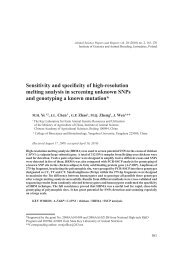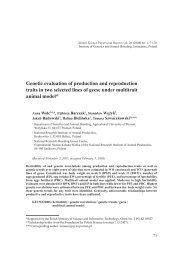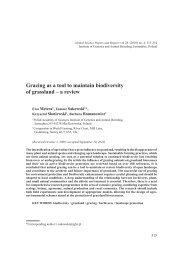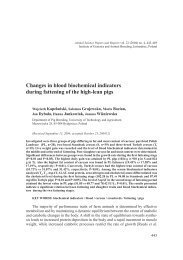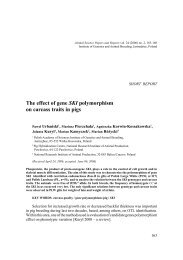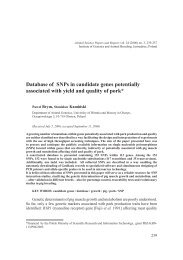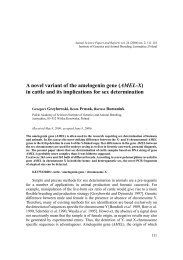Carcass quality, meat traits and chemical composition of meat in ...
Carcass quality, meat traits and chemical composition of meat in ...
Carcass quality, meat traits and chemical composition of meat in ...
Create successful ePaper yourself
Turn your PDF publications into a flip-book with our unique Google optimized e-Paper software.
Animal Science Papers <strong>and</strong> Reports vol. 21 (2003) no. 4, 251-263<br />
Institute <strong>of</strong> Genetics <strong>and</strong> Animal Breed<strong>in</strong>g, Jastrzębiec, Pol<strong>and</strong><br />
<strong>Carcass</strong> <strong>quality</strong>, <strong>meat</strong> <strong>traits</strong> <strong>and</strong> <strong>chemical</strong> <strong>composition</strong><br />
<strong>of</strong> <strong>meat</strong> <strong>in</strong> ducks <strong>of</strong> paternal stra<strong>in</strong>s A44 <strong>and</strong> A55*<br />
Adam Mazanowski 1,2 , Tomasz Kisiel 2 , Ewa Gornowicz 3<br />
1<br />
Department <strong>of</strong> Poultry Breed<strong>in</strong>g, University <strong>of</strong> Technology <strong>and</strong> Agriculture,<br />
Mazowiecka 28, 85-084 Bydgoszcz, Pol<strong>and</strong><br />
2<br />
Department <strong>of</strong> Poultry Breed<strong>in</strong>g, Dworzyska, National Research Institute <strong>of</strong> Animal Production,<br />
62-035 Kórnik, Pol<strong>and</strong><br />
3<br />
Poultry Research Branch Zakrzewo, National Research Institute <strong>of</strong> Animal Production,<br />
Poznańska 11, 62-069 Palędzie, Pol<strong>and</strong><br />
(Received July 3, 2003; accepted November 5, 2003)<br />
Analysed were 8-week-old males <strong>and</strong> females <strong>of</strong> duck paternal stra<strong>in</strong>s A44 <strong>and</strong> A55. The <strong>in</strong> vivo<br />
weights <strong>of</strong> <strong>meat</strong> <strong>and</strong> fat with sk<strong>in</strong> were estimated based on live body weight, breast bone length<br />
<strong>and</strong> breast muscle thickness. Heritability coefficients for <strong>meat</strong> production <strong>traits</strong> <strong>and</strong> genetic <strong>and</strong><br />
phenotypic correlations between them were calculated. <strong>Carcass</strong>es were measured <strong>and</strong> dissected. In<br />
breast <strong>and</strong> leg muscles the pH <strong>and</strong> water hold<strong>in</strong>g capacity as well as water, prote<strong>in</strong>, fat <strong>and</strong> ash were<br />
determ<strong>in</strong>ed. Simple correlation coefficients were calculated between carcass weight with neck <strong>and</strong><br />
carcass components, <strong>and</strong> body measurements. A55 ducks <strong>of</strong> both sexes showed greater <strong>meat</strong> <strong>and</strong><br />
fat weight, but lower <strong>meat</strong> <strong>and</strong> higher fat content <strong>of</strong> carcass compared to A44 ducks. Based on the<br />
correlation coefficients between body measurements <strong>and</strong> body weight <strong>and</strong> carcass components, it is<br />
suggested that <strong>in</strong> order to <strong>in</strong>crease the <strong>meat</strong> weight <strong>in</strong> the carcass, both stra<strong>in</strong>s should be selected for<br />
body weight, <strong>and</strong> stra<strong>in</strong> A44 additionally for breast bone length <strong>and</strong> breast muscle thickness. Chest<br />
depth – which is positively <strong>and</strong> significantly correlated with the weight <strong>and</strong> content <strong>of</strong> breast <strong>and</strong> leg<br />
muscles <strong>of</strong> carcass, <strong>and</strong> negatively with the weight <strong>and</strong> content <strong>of</strong> subcutaneous fat with sk<strong>in</strong> – can<br />
be used <strong>in</strong> selection for <strong>in</strong>creased muscl<strong>in</strong>g <strong>and</strong> decreased carcass fatness. Also breast bone length<br />
<strong>and</strong> shank length, as well as chest <strong>and</strong> shank circumference can be used <strong>in</strong> the selection for <strong>in</strong>creased<br />
<strong>meat</strong> weight <strong>and</strong> decreased fat weight <strong>in</strong> duck carcass. It is concluded, based on the pH, water hold<strong>in</strong>g<br />
capacity <strong>and</strong> <strong>chemical</strong> analyses <strong>of</strong> breast <strong>and</strong> leg muscles, that the cul<strong>in</strong>ary value <strong>of</strong> stra<strong>in</strong> A55<br />
<strong>meat</strong> is higher than <strong>of</strong> stra<strong>in</strong> A44.<br />
* Conducted with<strong>in</strong> the statutory activity <strong>of</strong> the National Research Institute <strong>of</strong> Animal Production, Pol<strong>and</strong>,<br />
Project no. 1106.2.<br />
251
A. Mazanowski et al.<br />
KEY WORDS: carcass / <strong>chemical</strong> <strong>composition</strong> / duck / heritability / <strong>meat</strong><br />
Meat <strong>traits</strong> <strong>in</strong> ducks are <strong>of</strong> medium to high heritability [Kosba et al. 1997], what<br />
ensures successful selection. Useful guidel<strong>in</strong>es on how to carry out such selection are<br />
provided by simple correlations calculated between tissue components <strong>and</strong> <strong>in</strong> vivo body<br />
dimensions [Książkiewicz 1993ab, Książewicz <strong>and</strong> Kontecka 1993].<br />
The best slaughter age <strong>of</strong> ducks was found between 7 <strong>and</strong> 8 weeks <strong>of</strong> life [Bochno<br />
et al. 1988]. With<strong>in</strong> this range, the <strong>meat</strong> content <strong>of</strong> carcass was the highest <strong>and</strong> <strong>meat</strong> to<br />
fat ratio proved the most favourable [Bochno et al. 1984]. When the age <strong>of</strong> the ducks<br />
exceeds 8 weeks the muscles no longer ga<strong>in</strong> <strong>in</strong> weight, while the ga<strong>in</strong> <strong>of</strong> sk<strong>in</strong> with<br />
subcutaneous fat <strong>in</strong>creases [Górski 1990, 1997ab]. These conclusions can be drawn<br />
<strong>in</strong>directly from the body measurements, which are good <strong>in</strong>dicators <strong>of</strong> the birds’ growth,<br />
as well as from the direct dissection data [Witkiewicz 2000, Wołoszyn et al. 2002].<br />
Water hold<strong>in</strong>g capacity, pH <strong>and</strong> <strong>chemical</strong> <strong>composition</strong>, usually determ<strong>in</strong>ed <strong>in</strong> breast<br />
<strong>and</strong> leg muscles are crucial for the cul<strong>in</strong>ary value <strong>and</strong> technological properties <strong>of</strong> duck<br />
<strong>meat</strong> <strong>and</strong> have been <strong>in</strong>vestigated by many authors <strong>in</strong> relation to the birds’orig<strong>in</strong>, age<br />
<strong>and</strong> nutrition [Pikul et al. 1987, Knust <strong>and</strong> P<strong>in</strong>gel 1992, Witkiewicz 2000, Wołoszyn et<br />
al. 2002]. In no publication, however, described was the <strong>meat</strong> <strong>quality</strong> <strong>of</strong> Polish paternal<br />
duck stra<strong>in</strong>s selected for body weight over 20 years. This has been the subject <strong>of</strong> the<br />
present report, that aimed at characteriz<strong>in</strong>g comprehensively the <strong>meat</strong> <strong>traits</strong> <strong>of</strong> ducks<br />
from paternal stra<strong>in</strong>s A44 <strong>and</strong> A55, <strong>in</strong> terms <strong>of</strong> direct <strong>in</strong>dicators <strong>and</strong> genetic parameters<br />
<strong>of</strong> their carcasses <strong>and</strong> <strong>chemical</strong> <strong>composition</strong> <strong>of</strong> the breast <strong>and</strong> leg muscles.<br />
Material <strong>and</strong> methods<br />
In 2002 two stra<strong>in</strong>s <strong>of</strong> <strong>meat</strong>-type ducks A44 <strong>and</strong> A55 were <strong>in</strong>vestigated at the<br />
Waterfowl Breed<strong>in</strong>g Farm, Dworzyska, Pol<strong>and</strong>, belong<strong>in</strong>g to the National Research<br />
Institute <strong>of</strong> Animal Production. Eight-week-old males <strong>and</strong> females were exam<strong>in</strong>ed<br />
for body weight, breast bone length, <strong>and</strong> breast muscle thickness. The weight <strong>of</strong> <strong>meat</strong><br />
(Y) <strong>and</strong> fat with sk<strong>in</strong> (U) was estimated with multiple regression equations derived by<br />
Bochno et al. [1988], as follows:<br />
where:<br />
Y = 0.193 X 1<br />
+ 45.778 X 2<br />
+ 14.267 X 3<br />
– 61.445 <strong>and</strong><br />
U = 0.247 X 1<br />
+ 62.091 X 2<br />
– 32.036 X 3<br />
+ 168.369<br />
X 1<br />
– live body weight at the age <strong>of</strong> 8 weeks (g);<br />
X 2<br />
– thickness <strong>of</strong> breast muscle with sk<strong>in</strong> at the age <strong>of</strong> 8 weeks, measured<br />
with a needle catheter 4 cm from the top <strong>of</strong> breast bone <strong>and</strong> 1.5 cm<br />
laterally from its edge (cm);<br />
X 3<br />
– length <strong>of</strong> breast bone at the age <strong>of</strong> 8 weeks (cm).<br />
The heritability coefficients <strong>of</strong> the <strong>meat</strong> <strong>traits</strong> were estimated with hierarchic analysis<br />
252
<strong>Carcass</strong> <strong>quality</strong> <strong>and</strong> <strong>meat</strong> <strong>traits</strong> <strong>in</strong> ducks<br />
<strong>of</strong> variance from dam component (h 2 ), sire component D (h2 ) <strong>and</strong> dam <strong>and</strong> sire components<br />
S<br />
(h 2 ). St<strong>and</strong>ard errors (SE) for heritability coefficients [Żuk 1979] were computed <strong>and</strong><br />
DS<br />
coefficients <strong>of</strong> dam effect c 2 [Wężyk 1971] estimated. The coefficients <strong>of</strong> genetic (r G<br />
) <strong>and</strong><br />
phenotypic (r P<br />
) correlations between the <strong>meat</strong> <strong>traits</strong> were estimated us<strong>in</strong>g the analysis <strong>of</strong><br />
variance <strong>and</strong> covariance, with the same model as for estimat<strong>in</strong>g h 2 .<br />
For dissection, five males <strong>and</strong> five females aged 8 weeks were chosen r<strong>and</strong>omly from<br />
each stra<strong>in</strong>. Their body weights were close to the stra<strong>in</strong> means for each sex. Selected<br />
birds were tape-measured with an accuracy <strong>of</strong> 1 mm for the length <strong>of</strong> trunk with neck,<br />
length <strong>of</strong> trunk, breast bone length <strong>and</strong> length <strong>of</strong> shank. Chest <strong>and</strong> shank circumferences<br />
were tape-measured, chest depth was measured with slide caliper <strong>and</strong> thickness<br />
<strong>of</strong> breast muscle with a needle catheter. After pluck<strong>in</strong>g <strong>and</strong> cool<strong>in</strong>g for about 20 hours,<br />
the carcasses were eviscerated <strong>and</strong> divided <strong>in</strong>to breast muscles, leg muscles, sk<strong>in</strong> with<br />
fat, <strong>and</strong> abdom<strong>in</strong>al fat [Ziołecki i Doruchowski 1989]. Simple correlation coefficients<br />
were calculated between the weight <strong>of</strong> carcass with neck <strong>and</strong> dress<strong>in</strong>g percentage,<br />
weight <strong>and</strong> per cent <strong>of</strong> breast <strong>and</strong> leg muscles, weight <strong>of</strong> sk<strong>in</strong> with subcutaneous fat,<br />
<strong>and</strong> body dimensions.<br />
The pH <strong>of</strong> breast <strong>and</strong> leg muscles was determ<strong>in</strong>ed 15 m<strong>in</strong> post-slaughter (pH 15<br />
)<br />
<strong>and</strong> after 20 h carcass cool<strong>in</strong>g (pH 24<br />
). Measurements were performed with a spear tip<br />
electrode comb<strong>in</strong>ed with a pH meter CP-401 (ELMETRON). The electrode was placed<br />
at an angle <strong>of</strong> 45°, halfway through the muscle, <strong>and</strong> pH values were read from an LCD<br />
display with an accuracy <strong>of</strong> 0.01. Water hold<strong>in</strong>g capacity was determ<strong>in</strong>ed accord<strong>in</strong>g to<br />
Grau <strong>and</strong> Hamm [1952]. To determ<strong>in</strong>e the <strong>meat</strong> <strong>chemical</strong> <strong>composition</strong>, breast muscles<br />
as well as leg <strong>and</strong> lower thigh muscles <strong>of</strong> the same leg were taken from each carcass<br />
side <strong>and</strong> then analysed <strong>in</strong>dividually. Breast <strong>and</strong> leg muscles were m<strong>in</strong>ced separately<br />
<strong>and</strong> homogenized <strong>in</strong> a food processor (Cuc<strong>in</strong>a HR 2831/6, PHILIPS). Chemical <strong>composition</strong><br />
<strong>of</strong> the breast <strong>and</strong> leg muscles (water, prote<strong>in</strong>, fat, ash) was determ<strong>in</strong>ed with<br />
rout<strong>in</strong>e procedures. The results were evaluated statistically with variance analysis <strong>and</strong><br />
estimation <strong>of</strong> significance <strong>of</strong> differences between stra<strong>in</strong>s <strong>and</strong> sexes.<br />
Results <strong>and</strong> discussion<br />
At the age <strong>of</strong> 8 weeks live body weights <strong>of</strong> birds <strong>of</strong> both sexes were greater <strong>in</strong> stra<strong>in</strong><br />
A55 than <strong>in</strong> A44 (Tab. 1) with SDs similar <strong>in</strong> both stra<strong>in</strong>s. A higher body weight <strong>of</strong><br />
A55 birds may be attributed to <strong>in</strong>troduc<strong>in</strong>g the genes <strong>of</strong> P8 ducks <strong>in</strong>to the A44 genotype<br />
[Książkiewicz 1993b]. The 8-week-old Pek<strong>in</strong>g ducks, which were selected abroad for<br />
<strong>in</strong>creased body weight, showed similar body weight [P<strong>in</strong>gel 1999]. Breast bone length<br />
<strong>and</strong> breast muscle thickness with sk<strong>in</strong> <strong>in</strong> Pek<strong>in</strong>g <strong>and</strong> A55 were similar, both <strong>in</strong> males<br />
<strong>and</strong> females. Pek<strong>in</strong>g ducks, selected <strong>in</strong> Germany, showed thicker breast muscles at the<br />
age 8 weeks [P<strong>in</strong>gel et al. 1997, P<strong>in</strong>gel 1999].<br />
The weight <strong>of</strong> <strong>meat</strong> <strong>and</strong> fat with sk<strong>in</strong> as calculated from the multiple regression<br />
equations, appeared greater <strong>in</strong> A55 males <strong>and</strong> females, as was per cent <strong>of</strong> fat with sk<strong>in</strong>.<br />
253
A. Mazanowski et al.<br />
In Polish studies [Witkiewicz 1998, Mazanowski et al. 1999a], A55 ducks created with<br />
the share <strong>of</strong> A44 <strong>and</strong> P8 stra<strong>in</strong>s, achieved at week 7 greater or similar weight <strong>of</strong> carcass<br />
<strong>meat</strong> (737-761 g) <strong>and</strong> a lower weight <strong>of</strong> fat with sk<strong>in</strong> (480-524 g) compared to the<br />
results <strong>of</strong> the present study achieved at week 8. Therefore, A55 ducks <strong>of</strong> both sexes are<br />
characterized by greater body weight <strong>and</strong> greater weight <strong>of</strong> both <strong>meat</strong> <strong>and</strong> fat <strong>in</strong> carcass<br />
than A44 ducks. However, A55 had a lower <strong>meat</strong> content, <strong>and</strong> a higher fat content <strong>of</strong><br />
carcass compared to A44 ducks (Tab. 1).<br />
In stra<strong>in</strong> A44, the dam’s effects on body weight, breast bone length, breast muscle<br />
thickness <strong>and</strong> weight <strong>of</strong> <strong>meat</strong> <strong>and</strong> fat <strong>in</strong> the carcass were greater than those <strong>of</strong> sires (h 2 D<br />
> h 2 ) – Table 2. Thus, the body weight <strong>of</strong> progeny ducks <strong>of</strong> A44 at 7 weeks <strong>of</strong> age was<br />
S<br />
more affected by dams than by sires, as also evidenced by the positive maternal effects<br />
(c 2 ). In stra<strong>in</strong> A55 the dam effect was manifested <strong>in</strong> breast bone length <strong>and</strong> breast<br />
muscle thickness, <strong>and</strong> the sire effect <strong>in</strong> body weight <strong>and</strong> weight <strong>of</strong> fat with sk<strong>in</strong>. In A55<br />
the maternal effect appeared very small or even negative. The h 2 coefficients <strong>in</strong> stra<strong>in</strong><br />
DS<br />
A44 reached predom<strong>in</strong>antly moderate values except for the thickness <strong>of</strong> breast muscle<br />
254
<strong>Carcass</strong> <strong>quality</strong> <strong>and</strong> <strong>meat</strong> <strong>traits</strong> <strong>in</strong> ducks<br />
(h 2 = 0.236).<br />
DS<br />
In stra<strong>in</strong> A55 the h 2 coefficients for body, <strong>meat</strong> <strong>and</strong> fat weights were high, while<br />
DS<br />
those for breast bone length <strong>and</strong> breast muscle thickness appeared moderate. In the<br />
earlier studies, the coefficients <strong>of</strong> heritability for body weight <strong>in</strong> A44 <strong>and</strong> A55 ducks<br />
were found lower [Mazanowski et al. 1999ab]. The h 2 coefficients for breast bone<br />
DS<br />
length, estimated by Mazanowski et al. [1999a] <strong>in</strong> progeny <strong>of</strong> both sexes were 0.308<br />
<strong>and</strong> 0.323 <strong>in</strong> A44 <strong>and</strong> A55, respectively, i.e. lower than reported here, while the h 2 DS<br />
values for breast muscle thickness appeared similar.<br />
The heritability coefficients <strong>and</strong> the estimated effects <strong>of</strong> dams show that when select<strong>in</strong>g<br />
A44 ducks for <strong>in</strong>creased muscl<strong>in</strong>g, more attention should be paid to the choice<br />
<strong>of</strong> dams for the selection flock. In stra<strong>in</strong> A55, the effect <strong>of</strong> dams on <strong>meat</strong> <strong>traits</strong> <strong>of</strong> their<br />
<strong>of</strong>fspr<strong>in</strong>g was small <strong>and</strong> mostly similar to that <strong>of</strong> sires. The h 2 coefficients for body,<br />
DS<br />
<strong>meat</strong> <strong>and</strong> fat weights were the highest.<br />
In the 8-week-old males <strong>and</strong> females <strong>of</strong> A44, body weight was highly correlated with<br />
breast bone length <strong>and</strong> weight <strong>of</strong> <strong>meat</strong> <strong>and</strong> fat <strong>in</strong> carcass, breast bone length with breast<br />
muscle thickness, <strong>meat</strong> <strong>and</strong> fat weights, <strong>and</strong> <strong>meat</strong> weight with fat weight. (Tab. 3). In<br />
both sexes <strong>of</strong> A55 the coefficients <strong>of</strong> genetic correlation were high between body weight<br />
<strong>and</strong> <strong>meat</strong> <strong>and</strong> fat weights, <strong>and</strong> between <strong>meat</strong> weight <strong>and</strong> fat weight. The other r G<br />
between<br />
the <strong>meat</strong> <strong>traits</strong> as well as the r P<br />
appeared lower. In the earlier studies, both the r G<br />
<strong>and</strong> r P<br />
<strong>in</strong> A44 <strong>and</strong> A55 ducks were found similar [Mazanowski 1999a]. To ensure successful<br />
selection for <strong>meat</strong> weight, both stra<strong>in</strong>s should be selected for body weight, <strong>and</strong> stra<strong>in</strong><br />
A44 additionally for breast bone length <strong>and</strong> breast muscle thickness.<br />
255
A. Mazanowski et al.<br />
At slaughter dissected A44 males <strong>and</strong> females had a significantly lower body weight<br />
as well as lower per cent <strong>of</strong> leg muscles, while higher dress<strong>in</strong>g percentage, per cent <strong>of</strong><br />
sk<strong>in</strong> with subcutaneous fat <strong>and</strong> weight <strong>of</strong> abdom<strong>in</strong>al fat than A55 males <strong>and</strong> females<br />
(Tab. 4). Sexual dimorphism only appeared <strong>in</strong> the body weight <strong>and</strong> carcass weight.<br />
There were no significant <strong>in</strong>ter-stra<strong>in</strong> differences <strong>in</strong> breast muscles content <strong>of</strong> carcass.<br />
In a previous study by Mazanowski et al. [2001], four-stra<strong>in</strong> crosses <strong>of</strong> ducks with<br />
A44 <strong>and</strong> A55 share showed both dress<strong>in</strong>g percentage <strong>and</strong> weight <strong>of</strong> abdom<strong>in</strong>al fat to<br />
<strong>in</strong>crease dur<strong>in</strong>g the growth period. A similar proportion <strong>of</strong> sk<strong>in</strong> with subcutaneous fat<br />
(from 28.1 to 32%) was characteristic <strong>of</strong> A55 males <strong>and</strong> females [Mazanowski 1999a].<br />
A55 ducks <strong>of</strong> both sexes aged 8 weeks exhibited a greater weight <strong>of</strong> eviscerated carcass<br />
with neck, had well muscled legs <strong>and</strong> were less fatty than A44 ducks (Tab. 4).<br />
Eviscerated carcass with neck was significantly <strong>and</strong> positively correlated with length<br />
<strong>of</strong> trunk with neck, length <strong>of</strong> trunk, breast bone length <strong>and</strong> chest circumference (Tab. 5).<br />
Breast <strong>and</strong> leg muscles contents (%) were significantly <strong>and</strong> positively correlated with<br />
the majority <strong>of</strong> body measurements except for a non-significant correlation with breast<br />
muscle thickness. Książkiewicz [1993b] <strong>in</strong> 7-week-old A44 ducks <strong>of</strong> both sexes found<br />
significant correlations between the weight <strong>of</strong> breast <strong>and</strong> leg muscles <strong>and</strong> the length <strong>of</strong><br />
breast bone as well as breast muscle thickness. Moreover, he ascerta<strong>in</strong>ed the significant<br />
<strong>and</strong> negative correlations appear<strong>in</strong>g between the weight <strong>of</strong> sk<strong>in</strong> with subcutaneous fat<br />
<strong>and</strong> breast bone length, shank length, <strong>and</strong> chest depth. In other studies, the correlation<br />
coefficients between weight <strong>of</strong> sk<strong>in</strong> with subcutaneous fat <strong>and</strong> body measurements <strong>of</strong><br />
A44 <strong>and</strong> A55 ducks <strong>of</strong> both sexes were not found significant <strong>and</strong> <strong>in</strong> most cases appeared<br />
negative [Książkiewicz 1993ab].<br />
Accord<strong>in</strong>g to Table 5 the dress<strong>in</strong>g percentage was significantly <strong>and</strong> negatively correlated<br />
with breast bone length <strong>and</strong> shank length, as well as with chest <strong>and</strong> shank cir-<br />
256
<strong>Carcass</strong> <strong>quality</strong> <strong>and</strong> <strong>meat</strong> <strong>traits</strong> <strong>in</strong> ducks<br />
257
A. Mazanowski et al.<br />
cumference. Breast <strong>and</strong> leg muscles<br />
contents <strong>of</strong> carcass were significantly<br />
<strong>and</strong> positively correlated with chest<br />
depth, while per cent <strong>of</strong> sk<strong>in</strong> with<br />
subcutaneous fat significantly <strong>and</strong><br />
negatively correlated with most <strong>of</strong><br />
body measurements, except trunk<br />
length with neck <strong>and</strong> breast muscle<br />
thickness. Conclud<strong>in</strong>g, the chest<br />
depth, which is positively (P≤0.05)<br />
correlated with weight <strong>and</strong> per cent<br />
<strong>of</strong> breast <strong>and</strong> leg muscles <strong>of</strong> carcass,<br />
<strong>and</strong> negatively (P≤0.05) with weight<br />
<strong>and</strong> per cent <strong>of</strong> sk<strong>in</strong> with subcutaneous<br />
fat, can be used <strong>in</strong> the selection<br />
for <strong>in</strong>creased muscl<strong>in</strong>g <strong>and</strong> decreased<br />
fatness <strong>in</strong> ducks. Suitable for selection<br />
for <strong>in</strong>creas<strong>in</strong>g <strong>meat</strong> weight <strong>and</strong><br />
decreas<strong>in</strong>g weight <strong>and</strong> per cent <strong>of</strong><br />
sk<strong>in</strong> with subcutaneous fat are also<br />
breast bone length, shank length <strong>and</strong><br />
chest <strong>and</strong> shank circumferences.<br />
Values <strong>of</strong> pH 15<br />
<strong>and</strong> pH 24<br />
(Tab. 6)<br />
were significantly higher <strong>in</strong> the breast<br />
muscles <strong>of</strong> A55 than A44 birds (both<br />
sexes), while pH 15<br />
<strong>in</strong> leg muscles<br />
was higher <strong>in</strong> A44. P<strong>in</strong>gel <strong>and</strong> Birla<br />
[1981a] <strong>in</strong> 8-week-old Pek<strong>in</strong>g ducks<br />
found the pH 45<br />
to range from 5.9 to<br />
6.0, <strong>and</strong> pH 24<br />
from 5.8 to 5.9. The pH<br />
values cited appear lower than those<br />
found <strong>in</strong> the present study, while pH 24<br />
<strong>of</strong> leg muscles is greater (6.1 to 7.1)<br />
<strong>in</strong> 7-week-old Pek<strong>in</strong>gs [P<strong>in</strong>gel <strong>and</strong><br />
Knust 1993, 1997].<br />
Water hold<strong>in</strong>g capacity <strong>of</strong> breast<br />
<strong>and</strong> leg muscles appeared high <strong>in</strong><br />
both stra<strong>in</strong>s. Drip loss <strong>in</strong> breast muscles<br />
ranged from 30.0 to 33.8% <strong>and</strong><br />
was similar to that found by P<strong>in</strong>gel<br />
<strong>and</strong> Birla [1981ab]. In the leg muscles,<br />
however, drip loss was lower<br />
258
<strong>Carcass</strong> <strong>quality</strong> <strong>and</strong> <strong>meat</strong> <strong>traits</strong> <strong>in</strong> ducks<br />
259
A. Mazanowski et al.<br />
(from 28.2 to 28.9%).<br />
Water content <strong>of</strong> breast <strong>and</strong> leg muscles <strong>in</strong> A44 was significantly lower than <strong>in</strong> A55<br />
stra<strong>in</strong>. Accord<strong>in</strong>g to Witkiewicz [1998, 2000] water content <strong>of</strong> muscles <strong>of</strong> 7-week-old<br />
A44 <strong>and</strong> A55 birds ranged from 75.2 to 76.6 <strong>and</strong> was greater than reported here for 8-<br />
week-old ducks. An even greater water content <strong>of</strong> breast muscle <strong>in</strong> Pek<strong>in</strong>g ducks was<br />
reported by Smith et al. [1993]. The prote<strong>in</strong> content <strong>of</strong> breast muscle <strong>and</strong> fat <strong>of</strong> leg<br />
muscles were both significantly lower <strong>in</strong> A55 birds. In terms <strong>of</strong> the prote<strong>in</strong> proportion<br />
<strong>in</strong> leg muscles <strong>and</strong> fat proportion <strong>in</strong> breast muscles, no significant differences between<br />
males <strong>and</strong> females <strong>of</strong> both stra<strong>in</strong>s were observed.<br />
Accord<strong>in</strong>g to Witkiewicz [1998, 2000] <strong>in</strong> 7-week-old A44 <strong>and</strong> A55 ducks <strong>of</strong> both<br />
sexes, the prote<strong>in</strong> content <strong>of</strong> breast muscles was 21.1 <strong>and</strong> 20.7%, respectively, be<strong>in</strong>g<br />
higher than reported <strong>in</strong> the present study. An even greater prote<strong>in</strong> content <strong>of</strong> breast<br />
muscles (21.5%) <strong>and</strong> leg muscles (22.5%) <strong>of</strong> Pek<strong>in</strong>g ducks was noted by Bons et al.<br />
[1998, 1999]. The fat contents <strong>of</strong> breast muscle <strong>of</strong> 7-week-old A44 <strong>and</strong> A55 males (1.4<br />
<strong>and</strong> 2.3%, respectively) <strong>and</strong> females (2.0 <strong>and</strong> 2.5%, respectively) as determ<strong>in</strong>ed by<br />
Witkiewicz [1998, 2000], were similar or lower than shown <strong>in</strong> the present report. The<br />
fat content <strong>of</strong> breast muscles higher than reported here was found <strong>in</strong> Pek<strong>in</strong>g ducks by<br />
Bons et al. [1998, 1999], P<strong>in</strong>gel <strong>and</strong> Birla [1981ab] <strong>and</strong> Smith et al. [1993].<br />
In the present study, the fat content <strong>of</strong> breast muscles was low (1.7%), while <strong>in</strong><br />
leg muscles markedly higher (3.9%). The ash content <strong>of</strong> breast <strong>and</strong> leg muscles did<br />
not differ significantly between the two stra<strong>in</strong>s. Bons et al. [1999] <strong>in</strong> leg muscles <strong>of</strong><br />
7-week-old ducks reported a higher content <strong>of</strong> ash (1.4%) than <strong>in</strong> 8-week-old A44<br />
<strong>and</strong> A55 ducks <strong>of</strong> both sexes (1.1%). In the present study, mean ash content <strong>of</strong> breast<br />
muscles (for both sexes <strong>and</strong> both stra<strong>in</strong>s, n=20) was 1.4%. Based on pH, water hold<strong>in</strong>g<br />
capacity <strong>and</strong> <strong>chemical</strong> analyses <strong>of</strong> breast <strong>and</strong> leg muscles, a higher cul<strong>in</strong>ary value <strong>of</strong><br />
A55 than A44 <strong>meat</strong> can be anticipated.<br />
The results presented here can be summarized as follows. Males <strong>and</strong> females<br />
<strong>of</strong> stra<strong>in</strong> A55 are dist<strong>in</strong>guished by higher live body weight <strong>and</strong> greater <strong>meat</strong> <strong>and</strong> fat<br />
weight <strong>in</strong> carcass, as well as better cul<strong>in</strong>ary value <strong>of</strong> <strong>meat</strong> compared to A44 stra<strong>in</strong>.<br />
Based on the correlation coefficients between body weight, tissue components <strong>and</strong><br />
body measurements, it is anticipated that <strong>in</strong>creas<strong>in</strong>g <strong>meat</strong> weight requires selection<br />
<strong>in</strong> both stra<strong>in</strong>s for body weight, <strong>and</strong> <strong>in</strong> A44 additionally for breast bone length <strong>and</strong><br />
breast muscle thickness. Chest depth can be used to <strong>in</strong>crease both the weight <strong>and</strong><br />
content <strong>of</strong> <strong>meat</strong>, <strong>and</strong> decrease both the weight <strong>and</strong> fat content <strong>of</strong> carcass. Also breast<br />
bone length <strong>and</strong> shank length, as well <strong>and</strong> chest <strong>and</strong> shank circumference can be used<br />
<strong>in</strong> the selection for <strong>in</strong>creased <strong>meat</strong> <strong>and</strong> reduced fat weight <strong>in</strong> a duck carcass.<br />
REFERENCES<br />
260
<strong>Carcass</strong> <strong>quality</strong> <strong>and</strong> <strong>meat</strong> <strong>traits</strong> <strong>in</strong> ducks<br />
1. BOCHNO R., LEWCZUK A., JANISZEWSKA A., MAZANOWSKI A., WAWRO K., 1988<br />
– Zastosowanie równań regresji wielokrotnej do oceny umięśnienia i otłuszczenia kaczek (Use <strong>of</strong><br />
multiple regression equations for evalution <strong>of</strong> muscle <strong>and</strong> fat weight <strong>of</strong> ducks). In Polish with English<br />
summary. Acta Academiae Agriculturae ac Technicae Olstenensis 31, 197-203.<br />
2. BOCHNO R., LEWCZUK A., WAWRO E., MAZANOWSKI A., 1984 – Tempo wzrostu ilości poszczególnych<br />
składników tkankowych w tuszkach kaczek (Growth rate <strong>of</strong> particular tissue components<br />
<strong>of</strong> ducks’ carcasses). In Polish with English summary. Przegląd Naukowej Literatury Zootechnicznej<br />
30 (3-4), 113-117.<br />
3. BONS A., TIMMLER R., JEROCH H., 1998 – Changes <strong>in</strong> body <strong>composition</strong> <strong>and</strong> content <strong>of</strong> fat<br />
<strong>and</strong> prote<strong>in</strong> <strong>in</strong> carcass <strong>of</strong> male <strong>and</strong> female Pek<strong>in</strong> ducks dur<strong>in</strong>g growth. Zeszyty Naukowe Przeglądu<br />
Hodowlanego 36, 165-175.<br />
4. BONS A., TIMMLER R., JEROCH H., 1999 – Changes <strong>in</strong> body <strong>composition</strong> <strong>and</strong> crude nutrient<br />
content <strong>of</strong> Pek<strong>in</strong> ducks dur<strong>in</strong>g growth. Proceed<strong>in</strong>gs <strong>of</strong> First World’s Waterfowl Conference, December<br />
1-4, Taichung, 328-332.<br />
5. GÓRSKI J., 1990 – Wzrost i proporcje podrobów, produktów ubocznych i składników tkankowych<br />
tuszki u kaczek rasy pek<strong>in</strong> w okresie odchowu (Growth <strong>and</strong> mutual ratio <strong>of</strong> giblets, <strong>of</strong>fals <strong>and</strong> tissue<br />
elements <strong>in</strong> Pek<strong>in</strong> duck carcasses dur<strong>in</strong>g rear<strong>in</strong>g period). In Polish with English summary. Przegląd<br />
Naukowej Literatury Zootechnicznej 35, 147-154.<br />
6. GÓRSKI J., 1997a – The effect <strong>of</strong> two-way crossbreed<strong>in</strong>g <strong>of</strong> Pek<strong>in</strong> ducks <strong>of</strong> P-11, P-22, P-44 <strong>and</strong><br />
P-55 stra<strong>in</strong>s on flesh<strong>in</strong>g <strong>and</strong> fatness <strong>of</strong> crossbred ducks. Proceed<strong>in</strong>gs <strong>of</strong> 11th European Symposium<br />
on Waterfowl. September 8-10, Nantes, 354-360.<br />
7. GÓRSKI J., 1997b – The effects <strong>of</strong> two-way crossbreed<strong>in</strong>g <strong>of</strong> Pek<strong>in</strong> ducks <strong>of</strong> P-11, P-22, P-44 <strong>and</strong><br />
P-55 stra<strong>in</strong>s <strong>of</strong> fat <strong>and</strong> prote<strong>in</strong> content <strong>in</strong> the muscles <strong>of</strong> crossbred ducks. Proceed<strong>in</strong>gs <strong>of</strong> 11th European<br />
Symposium on Waterfowl. September 8-10, Nantes, 362-367.<br />
8. GRAU R., HAMM R., 1952 – E<strong>in</strong>e e<strong>in</strong>fache Methode zur Bestimmung der Wasser-b<strong>in</strong>dung im<br />
Fleisch. Fleischwirtschaft 4, 295-297.<br />
9. KNUST U., PINGEL H., 1992 – The effect <strong>of</strong> <strong>in</strong>itial pH-value <strong>in</strong> duck breast <strong>and</strong> thigh muscle<br />
on other <strong>meat</strong> characteristics. Proceed<strong>in</strong>gs <strong>of</strong> the 19th World’s Poultry Congress. September 20-24,<br />
Amsterdam, 3, 221-224.<br />
10. KOSBA M.A., NEGM H. M., EL-SAYED T.M., 1997 – Selection for breast <strong>meat</strong> weight <strong>of</strong> ducks.<br />
Proceed<strong>in</strong>gs <strong>of</strong> the 11th European Symposium on Waterfowl. September 8-10, Nantes, 348-352.<br />
11. KSIĄŻKIEWICZ J., 1993a– Zależności między składem tkankowym a niektórymi wymiarami tuszek<br />
kaczek angielskich i krajowych (Relationship between the tissue content <strong>and</strong> some carcass dimensions<br />
<strong>of</strong> ducks with English <strong>and</strong> native orig<strong>in</strong>). In Polish with English summary. Zeszyty Naukowe<br />
Drobiarstwa COBRD Poznań 8, 57-65.<br />
12. KSIĄŻKIEWICZ J., 1993b – Wskaźniki zawartości mięśni piersiowych lub nóg w tuszkach kaczek<br />
z dwóch rodów hodowlanych (Indices <strong>of</strong> carcass breast muscle <strong>and</strong> leg content <strong>in</strong> two breed<strong>in</strong>g<br />
stra<strong>in</strong>s <strong>of</strong> ducks). In Polish with English summary. Roczniki Naukowe Zootechniki 20 (2), 65-75.<br />
13. KSIĄŻKIEWICZ J., KONTECKA H., 1993 – Charakterystyka zależności między masą i wymiarami<br />
ciała a składem tkankowym tuszek kaczek m<strong>in</strong>i, orp<strong>in</strong>gtonów i z różnym udziałem khaki campbell (A<br />
characteristics <strong>of</strong> dependence between body weight, body measurements <strong>and</strong> carcass tissue <strong>composition</strong><br />
<strong>of</strong> M<strong>in</strong>i-Duck, Orp<strong>in</strong>gton <strong>and</strong> duck with different content <strong>of</strong> Khaki Campbell ). In Polish with<br />
English summary. Roczniki Akademii Rolniczej w Poznaniu 246, 45-56.<br />
14. MAZANOWSKI A., KSIĄŻKIEWICZ J., KISIEL T., 1999a – Reproductive <strong>traits</strong> <strong>of</strong> ducks from<br />
paternal stra<strong>in</strong>s <strong>in</strong> two lay<strong>in</strong>g periods <strong>and</strong> <strong>meat</strong> <strong>traits</strong> <strong>of</strong> their <strong>of</strong>fspr<strong>in</strong>g. Annals <strong>of</strong> Animal Science<br />
– Roczniki Naukowe Zootechniki 26 (4), 205-217.<br />
15. MAZANOWSKI A., KSIĄŻKIEWICZ J., KISIEL T., 2001 – Ocena cech mięsnych czterorodowych<br />
kaczek mieszańców (Evaluation <strong>of</strong> <strong>meat</strong> <strong>traits</strong> <strong>in</strong> four-stra<strong>in</strong> crossbred ducks). In Polish with English<br />
summary. Roczniki Naukowe Zootechniki 28 (1), 25-43.<br />
261
A. Mazanowski et al.<br />
16. MAZANOWSKI A., KSIĄŻKIEWICZ J., SZUKALSKI G., 1999b – Reproductive <strong>traits</strong> <strong>of</strong> ducks<br />
from maternal stra<strong>in</strong>s <strong>in</strong> two lay<strong>in</strong>g periods <strong>and</strong> <strong>meat</strong> <strong>traits</strong> <strong>of</strong> their <strong>of</strong>fspr<strong>in</strong>g. Roczniki Naukowe<br />
Zootechniki 26 (4), 191-203.<br />
17. PIKUL J., DORUCHOWSKI W., TAŃSKI S., REKSIŃSKI T., 1987 – Porównanie wydajności<br />
poubojowej i dysekcyjnej, składu chemicznego oraz właściwości technologicznych mięsa kaczek<br />
piżmowych i Pek<strong>in</strong> (Slaughter yields, carcass <strong>composition</strong>, <strong>chemical</strong> analysis <strong>and</strong> technological properties<br />
<strong>of</strong> muscovy <strong>and</strong> Pek<strong>in</strong> ducks). In Polish with English summary. Zeszyty Naukowe Drobiarstwa<br />
4, 73-92.<br />
18. PINGEL H., BIRLA M., 1981a – Wpływ czynników przedubojowych na jakość tuszki u ptactwa<br />
wodnego (The effect <strong>of</strong> antemortem factors on the carcass <strong>quality</strong> <strong>of</strong> waterfowl). In Polish with English<br />
summary. Prace Badawcze Zakładu Hodowli Drobiu (Instytut Zootechniki) 9, 121-126.<br />
19. PINGEL H., BIRLA M., 1981b – Poprawa jakości tuszki kaczek przez selekcję (Improvement <strong>of</strong> duck<br />
carcass <strong>quality</strong> by selection). In Polish with English summary. Prace Badawcze Zakładu Hodowli<br />
Drobiu (Instytut Zootechniki) 9, 127-131.<br />
20. PINGEL H. 1999. Influence <strong>of</strong> breed<strong>in</strong>g <strong>and</strong> management <strong>of</strong> the efficiency <strong>of</strong> duck production. Lohmann<br />
Information 22, 7-13<br />
21. PINGEL H., KNUST U., 1993 – Review on ducks <strong>meat</strong> <strong>quality</strong>. Proceed<strong>in</strong>gs <strong>of</strong> the 11th European<br />
Symposium on the Quality <strong>of</strong> Poultry Meat. October 4-8, Tours, 26-38.<br />
22. PINGEL H., KNUST U., 1997 – Review on duck <strong>meat</strong> <strong>quality</strong>. Proceed<strong>in</strong>gs <strong>of</strong> 11-th European<br />
Symposium on the Quality <strong>of</strong> Poultry Meat. October 4-8, Tours, pp. 26-38.<br />
23. PINGEL H., MÜLLER J., LAM P.T., KNUST U., 1997 – Effect <strong>of</strong> selection for high feed efficiency<br />
on <strong>meat</strong> <strong>quality</strong> <strong>of</strong> Pek<strong>in</strong> ducks. Proceed<strong>in</strong>gs <strong>of</strong> the 13th European Symposium on the Quality <strong>of</strong><br />
Poultry Meat. September 21-26, Poznań, Pol<strong>and</strong>, 90-94.<br />
24. SMITH D.P., FLETCHER D.L., BUHR R.J., BEYER R.S., 1993 – Peck<strong>in</strong>g duckl<strong>in</strong>g <strong>and</strong> broiler<br />
chicken pectoralis muscle structure <strong>and</strong> <strong>composition</strong>. Poultry Science 72, 202-208.<br />
25. WITKIEWICZ K., 1998 – Porównanie kaczek z dwóch rodów hodowlanych pod względem wybranych<br />
cech przyżyciowych i poubojowych (Comparison <strong>of</strong> ducks from two breed<strong>in</strong>g stra<strong>in</strong>s with regard to<br />
some selected live <strong>and</strong> slaughter <strong>traits</strong>). In Polish with English summary. Roczniki Akademii Rolniczej<br />
w Poznaniu 302, 243-251.<br />
26. WITKIEWICZ K., 2000 – Pomiary zoometryczne, wartość rzeźna i skład chemiczny mięśnia<br />
piersiowego u dwu rodów kaczek typu pek<strong>in</strong> (Zoometric measurements, slaughter value <strong>and</strong> <strong>chemical</strong><br />
<strong>composition</strong> <strong>of</strong> the breast muscle <strong>in</strong> two stra<strong>in</strong>s <strong>of</strong> ducks <strong>of</strong> Pek<strong>in</strong> type). In Polish with English<br />
summary. Roczniki Akademii Rolniczej w Poznaniu 330, 231-240.<br />
27. WOŁOSZYN J., KSIĄŻKIEWICZ J., ORKUSZ A., SKRABKA-BŁOTNICKA T., BIERNAT J.,<br />
KISIEL T., 2002 – Prelim<strong>in</strong>ary evaluation <strong>of</strong> <strong>chemical</strong> <strong>composition</strong> <strong>of</strong> duck’s muscles from two<br />
Polish conservative flocks. Proceed<strong>in</strong>gs <strong>of</strong> 48th International Congress <strong>of</strong> Meat Science <strong>and</strong> Technology.<br />
August 25-30, Rome, 374-375.<br />
28. WĘŻYK S., 1971 – Metody szacowania odziedziczalności (Methods <strong>of</strong> heritability estimation). In<br />
Polish with English summary. Wyniki prac genetyczno-selekcyjnych Zakładu Hodowli Drobiu za rok<br />
1968/69. Instytut Zootechniki, 252, 5-23.<br />
29. ZIOŁECKI J., DORUCHOWSKI W., 1989 – Metody oceny wartości rzeźnej drobiu (Estimation<br />
methods <strong>of</strong> poultry slaughter value). In Polish. Published by COBRD, Poznań, Pol<strong>and</strong>, pp. 1-22.<br />
30. ŻUK B., 1979 – Metody genetyki populacji w hodowli zwierząt (Methods <strong>of</strong> population genetics <strong>in</strong><br />
animal breed<strong>in</strong>g). In Polish. PWRL Warszawa, II Edition.<br />
262<br />
Adam Mazanowski, Tomasz Kisiel, Ewa Gornowicz
<strong>Carcass</strong> <strong>quality</strong> <strong>and</strong> <strong>meat</strong> <strong>traits</strong> <strong>in</strong> ducks<br />
Charakterystyka cech mięsnych, wartości tuszek i chemicznego<br />
składu mięsa kaczek z rodów ojcowskich A44 i A55<br />
S t r e s z c z e n i e<br />
Analizowano cechy mięsne 8-tygodniowych kaczek obu płci z rodów ojcowskich A44 i A55. Obliczono<br />
wskaźniki odziedziczalności cech mięsnych oraz korelacji genetycznych i fenotypowych między<br />
nimi. Określono wymiary i podstawowe elementy tuszek. Między masą tuszki z szyją i jej elementami a<br />
wymiarami ciała obliczono wskaźniki korelacji prostej. Określono pH, wodochłonność i skład chemiczny<br />
mięśni piersiowych i mięśni nóg. Stwierdzono, że w 8 tygodniu życia, tuszki kaczek A55 obu płci cechuje<br />
większa masa mięsa i tłuszczu, ale mniejszy udział (%) mięsa i większy udział (%) tłuszczu niż tuszki<br />
kaczek A44.<br />
Wskaźniki korelacji między masą ciała i elementami tuszki a wymiarami ciała pozwalają przypuszczać,<br />
że dla zwiększenia masy mięsa należy w obu rodach prowadzić selekcję na masę ciała, a w A44 także na<br />
długość mostka i grubość mięśni piersiowych. Głębokość klatki piersiowej, która jest dodatnio i istotnie<br />
skorelowana z masą i udziałem (%) mięśni piersiowych i mięśni nóg, a ujemnie z masą i udziałem (%)<br />
tłuszczu podskórnego ze skórą, nadaje się do wykorzystania w selekcji prowadzonej na wzrost umięśnienia<br />
i zmniejszenie otłuszczenia tusz kaczek.<br />
W selekcji zmierzającej do zwiększenia masy mięsa, a zmniejszenia masy tłuszczu można by<br />
wykorzystać także długość mostka, długość i obwód skoku oraz obwód klatki piersiowej. Na podstawie<br />
pH, wodochłonności i zawartości wody, białka, tłuszczu i popiołu w mięśniach piersiowych i mięśniach<br />
nóg, autorzy wnioskują o wyższej wartości kul<strong>in</strong>arnej mięsa kaczek rodu A55 niż A44.<br />
263
264



